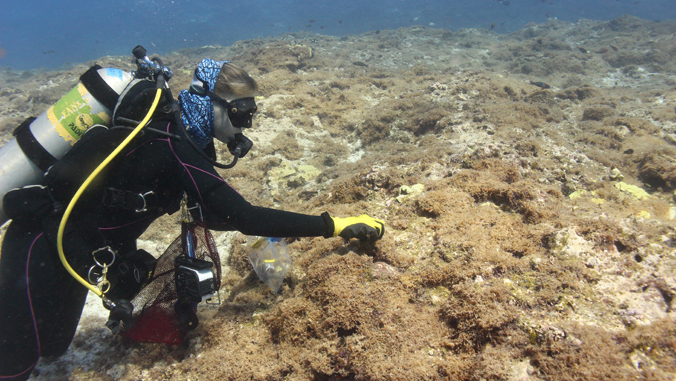
A new species of nuisance algae, which was formally described in 2020 by University of Hawaiʻi at Mānoa experts, continues to smother more reefs and coral at Papahānaumokuākea Marine National Monument. However, an early detection technique developed by UH Mānoa researchers can identify small particles of the alga in the water, giving experts much more time to act before it blankets the reef. Scientists are also currently testing lethal methods to kill the alga.
Related UH News story: Algae species discovered infesting NW waters has been identified, July 7, 2020
Chondria tumulosa was first detected in 2016, and has since been observed smothering entire reefs and the corals, native algae and other organisms that live there. It has a “tumbleweed-like” growth with no known origin, and appears to easily detach and spread. UH Mānoa College of Natural Sciences Interim Associate Dean and Professor Alison Sherwood and her team formally named the alga in 2020.
Recent expeditions from 2019–21 to Manawai (Pearl and Hermes Atoll) have revealed thick mats smothering the reefs, and the alga has also been detected at Kuaihelani (Midway Atoll) in 2021 and 2022.

A team of UH Mānoa School of Life Sciences researchers, led by PhD candidate Patrick Nichols, used water samples collected at Manawai and Kuaihelani to develop a test to detect the presence of Chondria tumulosa DNA in the water before the problem gets out of hand. This valuable early detection method will allow resource managers to more efficiently and effectively monitor for new populations of the alga, inspect gear and equipment, and to rapidly deploy their containment techniques to prevent future spread.
“It’s pretty exciting to be part of this project because I know that it is useful and can be implemented pretty much immediately. It will have widespread impact,” Nichols said.
Nichols said the current bottleneck in the process is that he needs to wait for samples to be returned to Oʻahu from each expedition to test them. Access to Papahānaumokuākea has been limited for a variety of reasons, including the COVID-19 pandemic, high costs and limits on the infrastructure at Manawai and Kuaihelani. Nichols and School of Life Sciences Professor Peter Marko are developing a portable assay (investigative procedure) so research teams can test the water for the presence of the alga on location. They are working with and funded by the U.S. Fish and Wildlife Service (USFWS) to develop the technique and test it on research expeditions.
“An assay like this can be tested and validated in the lab, but we can’t assess its accuracy without samples from the real reefs,” Marko said. “We need more opportunities to get more samples from throughout the monument, especially from places where the alga hasn’t yet spread.”
How to kill the alga

UH Mānoa School of Ocean and Earth Science and Technology graduate student Mario Kaluhiokalani, working with Professor Brian Popp in the Department of Oceanography, was one of five researchers who embarked on a 17-day mission to Kuaihelani in August 2022 to further investigate Chondria tumulosa and determine the conditions that might be fueling its growth. The alga was observed at 30% of the 150 sites inspected, but only in high abundance at eight sites. Researchers said the patterns of distribution at Kuaihelani are similar to those found at Manawai in 2021, but with less mass formation.
Specimens were collected to investigate its population structure, reproductive state, composition and associated invertebrate communities. Water samples were sent to Nichols at UH Mānoa to test for the alga. Oceanographic data on temperature, nutrient levels and other parameters were also collected, and coral samples will be used to study “before” and “after” biogeochemical states of the coral reef food web in response to the infestation. The oceanographic work is being led by Andrea Kealoha, director of UH Maui College’s Water Quality Lab.
Scientists are conducting experiments to determine the lethal parameters required to kill the alga. Samples were subjected to a variety of chemical treatments, sun and shade exposures, and freezing treatments. The results will help with developing best management practices to prevent its spread.

This research was made possible by a grant from the National Fish and Wildlife Foundation to Sherwood, Marko, Kealoha, Popp and UH Mānoa, and funding from Hawaiʻi Sea Grant. Along with Kaluhiokalani, this latest expedition featured scientists from the National Oceanic and Atmospheric Association, College of Charleston, and U.S. Fish and Wildlife Service at Papahānaumokuākea, Midway Atoll National Wildlife Refuge and Battle of Midway National Memorial.
“Detecting Chondria tumulosa at Papahānaumokuākea sites outside of Manawai is a huge concern,” Sherwood said. “At the same time, it’s been really inspiring to see such a tremendous collaboration of UH researchers from multiple colleges and campuses, and resource managers from several different agencies coming together to tackle this problem head on.”
Partnering with the U.S. Fish and Wildlife Service
Since the discovery of the alga, USFWS has been working with UH researchers to develop tools to aid in its monitoring and detection in the waters of Papahānaumokuākea, the largest protected conservation area in the U.S. Kaʻuaʻoa Fraiola is a biologist with the USFWS Pacific Island Refuges and Monuments Office, and a UH alumnus in biology. He served as a member of the inter-agency working group that identified the need to develop an eDNA assay to detect the alga, sought involvement of UH researchers, and helped craft the cooperative agreement between UH and the USFWS that supports the eDNA assay development project.
“Due to Papahānaumokuākea’s extreme size and remoteness, traditional diver-based approaches to survey for Chondria tumulosa are not enough, especially in areas where it is newly established and difficult to see,” Fraiola said. “The incorporation of the latest ecological methods, such as eDNA, into our management tool belt makes it possible for us to survey and monitor large areas of reef for Chondria tumulosa quickly and simply. This partnership is critical.”
—By Marc Arakaki

